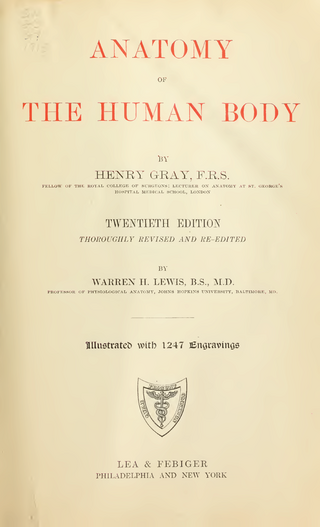Related Research Articles

Gray's Anatomy is a reference book of human anatomy written by Henry Gray, illustrated by Henry Vandyke Carter and first published in London in 1858. It has had multiple revised editions, and the current edition, the 42nd, remains a standard reference, often considered "the doctors' bible".

Polyuria is excessive or an abnormally large production or passage of urine. Increased production and passage of urine may also be termed as diuresis. Polyuria often appears in conjunction with polydipsia, though it is possible to have one without the other, and the latter may be a cause or an effect. Primary polydipsia may lead to polyuria. Polyuria is usually viewed as a symptom or sign of another disorder, but it can be classed as a disorder, at least when its underlying causes are not clear.

Parathyroid glands are small endocrine glands in the neck of humans and other tetrapods. Humans usually have four parathyroid glands, located on the back of the thyroid gland in variable locations. The parathyroid gland produces and secretes parathyroid hormone in response to low blood calcium, which plays a key role in regulating the amount of calcium in the blood and within the bones.

The pylorus connects the stomach to the duodenum. The pylorus is considered as having two parts, the pyloric antrum and the pyloric canal. The pyloric canal ends as the pyloric orifice, which marks the junction between the stomach and the duodenum. The orifice is surrounded by a sphincter, a band of muscle, called the pyloric sphincter. The word pylorus comes from Greek πυλωρός, via Latin. The word pylorus in Greek means "gatekeeper", related to "gate" and is thus linguistically related to the word "pylon".
Jing is the Chinese word for "essence", specifically Kidney essence. Along with qi and shen, it is considered one of the Three Treasures of traditional Chinese medicine.
Harcourt was an American publishing firm with a long history of publishing fiction and nonfiction for adults and children. The company was last based in San Diego, California, with editorial/sales/marketing/rights offices in New York City and Orlando, Florida, and was known at different stages in its history as Harcourt Brace, & Co. and Harcourt Brace Jovanovich. From 1919 to 1982, it was based in New York City.

In medicine, a nasopharyngeal airway, also known as an NPA, nasal trumpet, or nose hose, is a type of airway adjunct, a tube that is designed to be inserted through the nasal passage down into the posterior pharynx to secure an open airway. It was introduced by Hans Karl Wendl in 1958. When a patient becomes unconscious, the muscles in the jaw commonly relax and can allow the tongue to slide back and obstruct the airway. This makes airway management necessary, and an NPA is one of the available tools. The purpose of the flared end is to prevent the device from becoming lost inside the patient's nose.
Daniel F. Roses is an American surgeon who is the Jules Leonard Whitehill Professor of Surgery and Oncology of the New York University School of Medicine and a Senior Attending Surgeon at Tisch Hospital of the New York University Medical Center.
Holt McDougal is an American publishing company, a division of Houghton Mifflin Harcourt, that specializes in textbooks for use in high schools.
Sir James Cresseé Elphinstone Underwood FMedSci is a British pathologist who was awarded a knighthood for services to medicine in the 2005 New Year honours list.

The triangular space is one of the three spaces found at the axillary space. The other two spaces are the quadrangular space and the triangular interval.
Mosby is an academic publisher of textbooks and academic journals based in the United States.

Sir Leybourne Stanley Patrick Davidson was a British physician, medical investigator and author who wrote the medical textbook Principles and Practice of Medicine, which was first published in 1952.

Hugh MacPherson was a professor of acupuncture research at the University of York, founder and trustee of the Northern College of Acupuncture, founder and co-ordinator of the international STRICTA group, clinic director of York Clinic, fellow of The College of Medicine, and a practising member of the British Acupuncture Council.
Cecil Textbook of Medicine is a medical textbook published by Elsevier under the Saunders imprint.

Abeloff's Clinical Oncology is a medical reference work covering the field of oncology. First released in 1995 by Churchill Livingstone, it is currently published by Elsevier.
Miller's Anesthesia is an authoritative textbook on anesthesiology.
Avni Sali, is an Australian professor, surgeon, and academic primarily known for advocating an integrative approach to medicine, combining evidence-based complementary therapies with conventional medicine.

Ronald Stanley Illingworth FRCP was a British born Yorkshireman and a paediatrician of renown. He was also a prolific writer, who wrote some 600 articles and at least 21 books, which were exceedingly popular and sold in large quantities. Illingworth was principally known for being largely responsible for introducing the science and practice of paediatrics to the UK in the early to mid-1940s.

David Robert Harvey was a British paediatrician and considered by his peers to be a champion of the less privileged. Harvey was most notable for developing the training of neonatal medicine doctors at a time when the speciality had no official recognition. Harvey was homosexual and never afraid to disclose it, even at the beginning of his career, when homophobia was more prominent.
References
- ↑ "HARCOURT GENERAL TO BUY CHURCHILL LIVINGSTONE". The New York Times. Reuters. 16 August 1997. ISSN 0362-4331 . Retrieved 8 August 2021.
- ↑ Churchill Livingstone. JacketFlap.com. Accessed April 11, 2012.